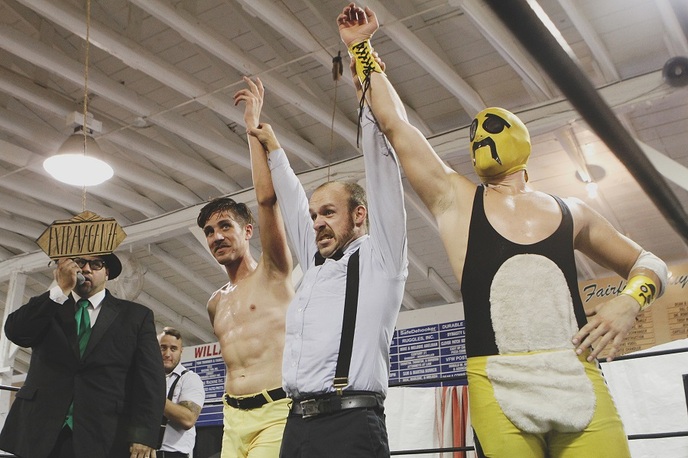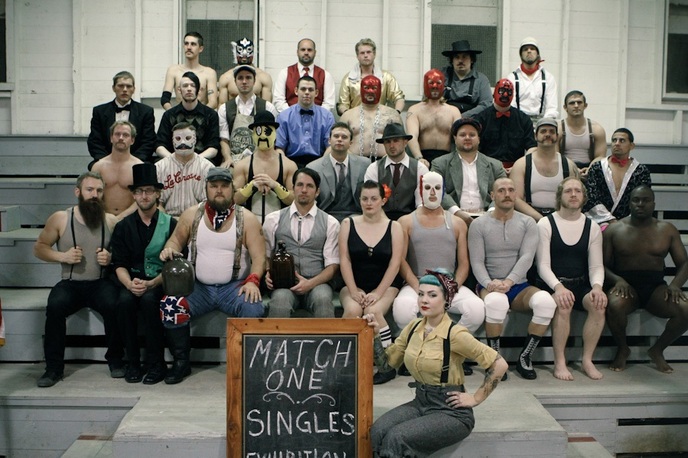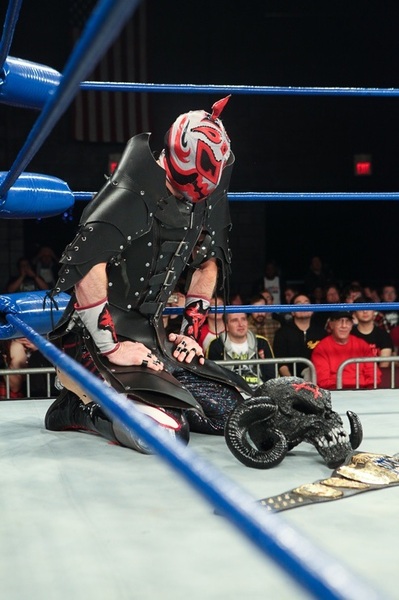Keeping Pro Wrestling Weird On The Indies
Main photo by Mia Obscura Photography / courtesy Party World Rasslin Wrestling Features Independent Wrestling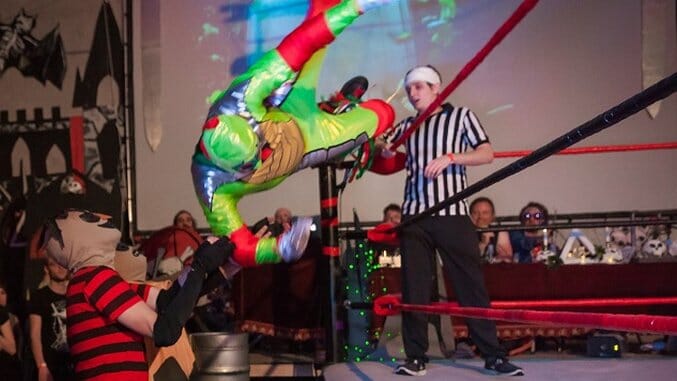
Tracey Smothers, a wrestling veteran of WWE, WCW and ECW, was awaiting his opponent on a summer day last year in Ohio. It was to be an unusual match in a lot of ways, not the least of which was that his adversary was no normal wrestler: On this day, Smothers was scheduled to wrestle a bear.
Smothers has actually wrestled a real live bear before. This was… not that. As the mighty black bear crawled out through the curtain on all fours, human wrists and ankles occasionally poking through a shabby outfit, it was clear what we were seeing was a joke. It all happened in a promotion called Olde Wrestling, which enlists performers with outlandish vintage gimmicks like bootleggers, strongmen, Pinkertons, and yes, bear wrestlers.
“I remember a woman or two shrieking when the bear came through the entranceway,” Olde Wrestling founder Justin Nottke says with a laugh. “Everybody knew Tracy Smothers wasn’t going to wrestle a real bear. But the sight of it, everybody was believing it just to encourage everyone else in the crowd.”
Matches and characters like those in Olde Wrestling are becoming more and more common around the American independent wrestling circuit, with absurd gimmicks and tons of fan participation. As the WWE transitions out of its so-called “Reality Era,” where a guy like MMA and amateur-wrestling star Brock Lesnar helped to “legitimize” sports entertainment, some indie wrestlers have drifted further into the other extreme, with weirder, hyper-niche promotions that are more interested in the artistic and comedic aspects of the medium.
And as independent wrestling becomes more popular, so too do alternative outfits like Olde Wrestling, Hoodslam in Oakland, G.O.U.G.E. from North Carolina, and more, all of which embrace wrestling’s absurd, funny, and fantastic aspects.
“We’re all in on the same joke, as far as wrestling goes,” Nottke says. “I think most fans know that it’s really just a performance art, and I think more than ever, they want to be involved.”
![]()
As Nottke points out, it’s not unfair to call wrestling what it is: a show. While the men and women in promotions like the WWE, Ring of Honor and TNA are all tremendous athletes, the show itself is predetermined. No one wants to hurt anyone, and rivalries are (usually) fabricated—like any other scripted show, the goal is to tell a story within the chosen medium.
Those stories can be told in a myriad of ways. For some, that means a traditional path towards Raw and Smackdown. But for those like Nottke, who also performs as mustachioed grappler Marion Fontaine, that was never the goal. For one, he said, his size isn’t exactly that of the WWE prototype. But he also never really had any specific end-game in mind other than to perform in front of an audience.
“To me, the wrestling ring is like a stage,” Nottke says. “You’re seeing these characters live, but then there’s also athletic feats, there’s also comedy, there’s all these different blends that come into play.”
Nottke wrestled with his vintage gimmick on the independent scene for years. At the time, only he and a few others were using similar styles: There was Dasher Hatfield, a masked, wrestling baseball player; There was also Thunderkitty, and old-timey women’s wrestler who, according to her bio, “[p]ossibly arrived to present day through time travel.”
It was Nottke’s girlfriend who first brought up the idea of rounding up all of these characters for a show set in the roaring ‘20s. And it wouldn’t just be established vintage characters: Nottke also convinced wrestlers like Matt Cross, perhaps best known as Lucha Underground’s Son of Havoc, to create their own vintage persona. Ultimately he was able to fill out his roster, and in 2013, Olde Wrestling had its first show, “An Extravaganza of Wrestling Exhibitions.”
Now, Olde Wrestling puts on three performances a year: A barn show, a “speakeasy” show in Cleveland, and one travelling show, each of which Nottke says gets a mixture of wrestling and non-wrestling fans alike.
“It’s really tongue-in-check, and we try and be as over-the-top as possible,” Nottke says. “Fans are like, ‘hey, this is a wrestling show, but we don’t have to be wrestling fans to enjoy it.’ And I don’t know if that was really my goal going into it, but now that I’ve heard it from people, I think that’s one of the best things about the show.”
![]()
Promotions like Nottke’s may be popping up more frequently, but his is not the first. As the 2000s rolled around, some smaller independent groups took the over-the-top concept of pro wrestling to the next logical step. Wrestling’s weird future was being forged by groups like Kaiju Big Battel, a Japanese monster wrestling group, and Chikara, which is to this day one of the more influential promotions in independent wrestling. (The company boasts alumni like the WWE’s Cesaro and Luke Harper).
Nottke lists Chikara as a major inspiration—a few Olde Wrestling performers, including Nottke himself, have wrestled there—and sees them as one of the innovators of this type of comedic, creative, fan-driven entertainment.
Chikara co-founder Mike Quackenbush never aspired to be a WWE “superstar.” Instead, he found inspiration from Japan and Mexico, and helped create a promotion he describes as “a comic book come to life,” a sort of love letter to his favorite aspects of pro wrestling.
“The most attractive elements in pro wrestling, as far as I was concerned, are those that intersect with comic books,” Quackenbush said. “Colorful characters, an ongoing narrative, a theme of good-versus-evil, superhuman feats of agility and strength.”
Those colorful characters include the Colony—a lucha libre ant colony—and an ancient Egyptian tag team known as the Osirian Portal. Matches are often sprinkled with fantastic elements: When wrestler Chuck Taylor threw an imaginary grenade toward the Colony at Chikara’s AniversarioCT in 2008, Soldier Ant sacrificed himself, with a slow-motion dive onto the imaginary explosive like something out of The Boys in Company C.
This kind of performance doesn’t come without its detractors. Through the years, Quackenbush has heard daily complaints from traditionalists who don’t see it as “real” pro wrestling. But it’s an argument rooted in ignorance, he says, tantamount to saying all music should sound a certain way: Just because something is unconventional doesn’t mean it isn’t worth taking seriously. In order to become successful, Chikara and other companies have had to show people that there’s more than one kind of “wrestling.”
“The hurdle is that so many people only know WWE, and they imagine that’s the only flavor out there,” Quackenbush said. “If that’s not to their taste, they don’t know where to turn for an alternative. Getting people to realize there are all these other flavors waiting for you to sample is the biggest thing preventing us from connecting to a larger audience.”
![]()
Like Quackenbush and Chikara, indie favorite Colt Cabana has dedicated much of his career to an over-the-top style of wrestling. A self-described “comedy wrestler,” the 36-year-old Cabana wrestles in more “traditional” matches, but also straddles the line, performing at the Gathering of the Juggalos as an uptight police officer named Officer Colt Cabana, and for the wrestling and burlesque group Lucha Vavoom in Los Angeles. This past year, he appeared on the season finale of The Chris Gethard Show, taking on, among others, a sumo-suit clad Jon Hamm. Cabana likes to boast that he’s wrestled in pretty much any setting you can think of.
Also like Quackenbush, Cabana hears some measure of pushback from so-called traditionalists. (Former promoter Jim Cornette once said about Cabana’s style, “funny doesn’t draw money.”) But while he respects other viewpoints in the business, he also doesn’t stay up at night worrying about what others think about his work.
“I’m in this weird position where I’m in my mid-30s and come from a little bit of the old school, but I’m obviously successful because of the new school,” Cabana says. “I get some of the flak, and I don’t let it bother me. I just make sure that I have an audience who enjoys my stuff.”
To Cabana and others like him, success in this way requires a do-it-yourself punk ethos: Rather than working towards playing the big arenas, find your people, and cater to them directly.
“These fringe-wrestling-type shows are anywhere from 50 to 1,000 people, and that’s a completely different show,” Cabana said. “When I go see comedy, I like being in these dingy little places. I know people are like that with music. Now, for the first time, that style of wrestling is being romanticized.”
![]()
Few companies know DIY more than the creators of Austin’s Party World Rasslin, a quarterly show that started as a backyard party with a couple-dozen friends. The group, which general manager Tim Faust calls “both a play about a wrestling league, and also a wrestling league,” crowdfunds every one of its shows and offers up free admission.
Fast-forward about two years later, and the group regularly boasts more than 1,000 people per show, and operates out of a local brewery. PWR touts characters like 4:20 Alien (a, uh, pot-smoking alien) and Luigi Primo, a pizza chef with a son made entirely of spaghetti.
“People buy into it, and they make their friends come, and then those friends make their friends come and that’s how it grows,” Faust says. “People come to our show because they care about a character, or they care about the party, or they care about the big spectacle, and they stick around.”
At their biggest show, a wrestling supercomputer named Deep Slam built a time portal into the future, which led to a human-versus-technology saga called Dark War. It was tons of planning that started out as a joke between friends, and became a large, collaborative effort. Every idea is explored, no matter how absurd. For example, there’s Bench Horse, a horse that knows how to bench press.
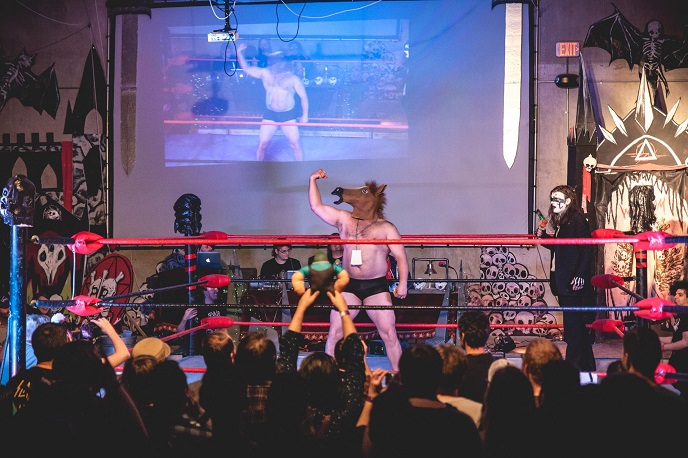
Like Olde Wrestling, PWR tries to make its shows as open to the non-wrestling fan as possible, and encourages women and LGBT fans to attend their performances. Like the band Speedy Ortiz, PWR has even set up a phone number that you can text if you’re feeling harassed at one of their shows.
All of this is done without any real amount of actual wrestling talent. While a local indie wrestler has started to train the PWR performers, so far it’s largely been in the basics. They even stray away from the term wrestling, preferring to call it “party violence”—their version of the WWE’s “sports entertainment.”
But that’s also not the point: No one who’s going to a PWR show is looking for Ric Flair vs. Ricky Steamboat. They’re looking for the characters, the gimmicks, the outlandish costumes and backstories. Which isn’t to say they’re trying to tear wrestling down, either. Ultimately, the wonderful, weird world of PWR, and other companies like it, is all about offering an alternative.
“We’re not looking to like disrespect anything that anybody’s doing, we just have our thing,” Monica said. “But also, I won’t apologize for anything. Because I think it’s important to stand up for what you do.
“Even if it’s a wacky, weird, comedy thing.”
Olde Wrestling and Chikara photographs by Zia Hiltey and courtesy the respective promotion.
Party World Rasslin photos by Mia Obscura Photography and courtesy Party World Rasslin.
